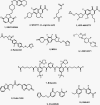Investigational drugs to treat methicillin-resistant Staphylococcus aureus
- PMID: 26536498
- PMCID: PMC5004000
- DOI: 10.1517/13543784.2016.1109077
Investigational drugs to treat methicillin-resistant Staphylococcus aureus
Abstract
Introduction: Staphylococcus aureus remains one of the leading causes of morbidity and mortality worldwide. This is to a large extent due to antibiotic-resistant strains, in particular methicillin-resistant S. aureus (MRSA). While the toll of invasive MRSA infections appears to decrease in U.S. hospitals, the rate of community-associated MRSA infections remains constant and there is a surge of MRSA in many other countries, a situation that calls for continuing if not increased efforts to find novel strategies to combat MRSA infections.
Areas covered: This review provides an overview of current investigational drugs and therapeutic antibodies against S. aureus in early clinical development (up to phase II clinical development). It includes a short description of the mechanism of action and a presentation of microbiological and clinical data.
Expert opinion: Increased recent antibiotic development efforts and results from pathogenesis research have led to several new antibiotics and therapies, such as anti-virulence drugs, as well as a more informed selection of targets for vaccination efforts against MRSA. This developing portfolio of novel anti-staphylococcal drugs will hopefully provide us with additional and more efficient ways to combat MRSA infections in the near future and prevent us from running out of treatment options, even if new resistances arise.
Keywords: Staphylococcus aureus; antibiotic resistance; antibiotics; quorum-sensing blockers; therapeutic antibodies; therapeutics; vaccine.
Figures
Similar articles
-
Investigational therapies targeting quorum-sensing for the treatment of Staphylococcus aureus infections.Expert Opin Investig Drugs. 2015 May;24(5):689-704. doi: 10.1517/13543784.2015.1019062. Epub 2015 Feb 23. Expert Opin Investig Drugs. 2015. PMID: 25704585 Free PMC article. Review.
-
Antimicrobial prescribing for treatment of serious infections caused by Staphylococcus aureus and methicillin-resistant Staphylococcus aureus in pediatrics: an expert review.Expert Rev Anti Infect Ther. 2021 Sep;19(9):1107-1116. doi: 10.1080/14787210.2021.1886923. Epub 2021 Feb 21. Expert Rev Anti Infect Ther. 2021. PMID: 33554692 Review.
-
Staphylococcus aureus epidemiology, pathophysiology, clinical manifestations and application of nano-therapeutics as a promising approach to combat methicillin resistant Staphylococcus aureus.Pathog Glob Health. 2024 May;118(3):209-231. doi: 10.1080/20477724.2023.2285187. Epub 2023 Nov 25. Pathog Glob Health. 2024. PMID: 38006316 Free PMC article. Review.
-
New drugs for methicillin-resistant Staphylococcus aureus: an update.J Antimicrob Chemother. 2013 Jul;68(7):1465-70. doi: 10.1093/jac/dkt045. Epub 2013 Feb 20. J Antimicrob Chemother. 2013. PMID: 23429643 Review.
-
Antibiotic susceptibility patterns of Staphylococcus aureus strains isolated at the Yaounde Central Hospital, Cameroon: a retro prospective study.Pan Afr Med J. 2019 Mar 5;32:103. doi: 10.11604/pamj.2019.32.103.15743. eCollection 2019. Pan Afr Med J. 2019. PMID: 31223393 Free PMC article.
Cited by
-
Computational Target-Based Screening of Anti-MRSA Natural Products Reveals Potential Multitarget Mechanisms of Action through Peptidoglycan Synthesis Proteins.ACS Omega. 2022 Oct 14;7(42):37896-37906. doi: 10.1021/acsomega.2c05061. eCollection 2022 Oct 25. ACS Omega. 2022. PMID: 36312373 Free PMC article.
-
Evaluation of short synthetic antimicrobial peptides for treatment of drug-resistant and intracellular Staphylococcus aureus.Sci Rep. 2016 Jul 11;6:29707. doi: 10.1038/srep29707. Sci Rep. 2016. PMID: 27405275 Free PMC article.
-
2,3-Dehydrokievitone combats methicillin-resistant Staphylococcus aureus infection by reducing alpha-hemolysin expression.Front Microbiol. 2022 Aug 23;13:969215. doi: 10.3389/fmicb.2022.969215. eCollection 2022. Front Microbiol. 2022. PMID: 36090058 Free PMC article.
-
Erythrocyte membrane-coated nanogel for combinatorial antivirulence and responsive antimicrobial delivery against Staphylococcus aureus infection.J Control Release. 2017 Oct 10;263:185-191. doi: 10.1016/j.jconrel.2017.01.016. Epub 2017 Jan 10. J Control Release. 2017. PMID: 28087406 Free PMC article.
-
Prevalence, predictors, and mortality of bloodstream infections due to methicillin-resistant Staphylococcus aureus in patients with malignancy: systemic review and meta-analysis.BMC Infect Dis. 2021 Jan 14;21(1):74. doi: 10.1186/s12879-021-05763-y. BMC Infect Dis. 2021. PMID: 33446122 Free PMC article.
References
Publication types
MeSH terms
Substances
Grants and funding
LinkOut - more resources
Full Text Sources
Other Literature Sources
Medical

